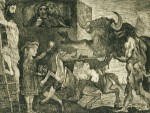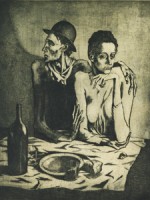Column Name
Title
Anything with the name “Picasso” is bound to draw crowds. But is there anything new to say about him? Happily, the answer is yes. “Picasso: Themes and Variations,” which opened last month at the Museum of Modern Art, is relatively quiet and intimate. I have not observed throngs or hoopla surrounding it. In fact, as of this moment—I always write my column a month in advance—there has not even been a major review.
The MoMA’s exhibit, “Picasso: Themes and Variations,” features 100 prints, including the 1935 work La Minotauromachie.
(Photo by © 2010 Estate of Pablo Picasso / Artists Rights Society (ARS), New York)Body
The exhibit is based on the Museum of Modern Art’s permanent collection, along with new acquisitions, and is limited to prints. Because of this, its appeal is not nearly as great as it would be if it were a painting exhibition. But prints formed a vital part of Picasso’s oeuvre—he made 2,400 of them. Even though I thought by now I would be familiar with every work in this small exhibit, there were things to be learned. Only 100 works comprise this display, but many of them count among the master’s lesser-known pieces. Incredibly, this scholarly, thoughtful, and beautiful show gives us a new perspective on Picasso. This lies mainly in the exploration of his process.
Picasso (1881–1973) thought of “themes” in his print series as his unique form of “writing fiction.” The show explores some of these in depth, demonstrating how Picasso developed a print through various stages. He did not consider each individual print in a series as the work of art, but rather the entire series—all together. According to the press release, Picasso “bemoaned the fact that, on canvas, such evolution (that evident in printmaking) disappears under layers of paint.” His 1945 11-step lithograph of a bull is a clear example of his process, from start to finish. In it, he begins with a complete animal, stripping it down in each successive print until the final state looks almost like a cave painting—just outlines.
Virtuosity was the main impression I got upon entering the first room. Saltimbanques (street circus performers), acrobats, horses, dogs, and even portraits dance with elegant lines. One etching of a deeply depressed couple, titled The Frugal Repast (1904), is recognizable as coming from his blue period. Though it is done only in black and white, the attenuated lines of fingers and body parts, as well as the dark shadows, evoke misery, just as the better-known oil paintings of the time do. This and the tiny drypoint The Watering Place (1906) recall similar paintings by Degas. Elegance and subtlety characterize Picasso’s works; we often observe the clarity of lines alternated with texture. He is a master of black and white and grays.
The Cubist Revolution, for which Picasso (along with Georges Braque) is credited, is primarily apparent here in the cases containing book illustrations, especially in the four small etchings from an illustrated book by Max Jacob, titledSaint Matorel, published in 1911.
It’s a truism by now, but nobody has ever surpassed the vitality, sensuality, and downright sexiness of Picasso. The animal force of his sexuality can enliven, be violent, and at times seem to scare even the artist himself. One of Picasso’s alter egos, the Minotaur, half-bull and half-man, appears numerous times along with other images from the 100-print “Vollard Suite” (1930-1937). Here we see a series of animals and people; bulls; and sleepers and watchers. Two “opposites”—overt sex and subtlety—live side by side in his prints. The culmination is his 1935 landmark etching La Minotauromachie. It contains meanings and metaphors much too complex to go into here, but they include the personal and the political, and are closely related to his most famous single painting, Guernica, of 1937.
A 1934 etching titled Large Bullfight reflects Picasso’s interrelationship with Surrealism, especially the automatism (psychic doodling) of his contemporaries, André Masson (1896-1987) and Roberto Matta (1911-2002). But there is also the delicacy of The Picador, a linoleum cut in 1959 that shows his affinities with Henri Matisse. It evokes the work of the Mexican muralist José Clemente Orozco (1883-1949). Faun Unveiling a Sleeping Girl (1936) cannot fail to remind one of Debussy and Nijinsky’s 1912 Après-midi d’un faune—one of the controversial pieces used by Sergei Diaghilev in his Ballets Russes, for which Picasso had designed costumes and sets. The concept of “themes and variations” is one usually used in association with music. And, in fact, almost all of the prints in the show can be related in some way to music, dance, and theater. Picasso’s 1910 cubist etchings parallel Arnold Schoenberg’s new atonal language, as well as his contemporary Wassily Kandinsky’s explorations. Very much like the composer Igor Stravinsky, Picasso is a chameleon, capable of innovation as well as tradition, and borrowing from others.
Like all comprehensive exhibitions of Picasso’s work, this one takes us on a journey through the history of art, music, dance, and theater of the 20th century, while at the same time evoking the past and predicting the future. There were references to Durer, Cranach, Rembrandt, El Greco, Velasquez, and also Degas, Manet, Matisse, as well as other contemporaries.
There is no question that Picasso is a titan. The work of his old age has no equal, except perhaps in that of Titian, Michelangelo, or Monet. During my student days it was fashionable to dislike his late works, but in the past few years they have been celebrated in several exhibitions. Here “Suite 347,” done over a seven-month period in 1968 when the artist was 86 (and named for the number of prints it contains), attests to his continued vigor and inventiveness. Seeing a retrospective of Picasso’s work is akin to attending a Shakespeare play. You keep seeing (“hearing”) familiar quotes—until you realize these began here. His images and inventions influenced so many who came after him.
Go see the show. But also look at the interactive site MoMA has set up online.
I usually do not write about the same museum two months in a row, but Juilliard students get free admission to MoMA. And in addition to the Picasso, the museum is filled with excellent shows: Kentridge (see the April issue of The Journal); Marina Abramovic; “The Modern Myth,” just to mention a few special exhibits. And this is not including their superb and ever-changing permanent collection.
“Picasso: Themes and Variations” runs through August 30 at the Museum of Modern Art, 11 West 53rd Street between Fifth and Sixth Avenues. The museum is open Sunday, Monday, Wednesday, Thursday, and Saturday from 10:30 a.m. to 5:30 p.m.; Friday from 10:30 a.m. to 8 p.m.; and until 8:45 p.m. June 3 and every Thursday in July and August; it is closed on Tuesday. (212) 708-9400; www.moma.org.






